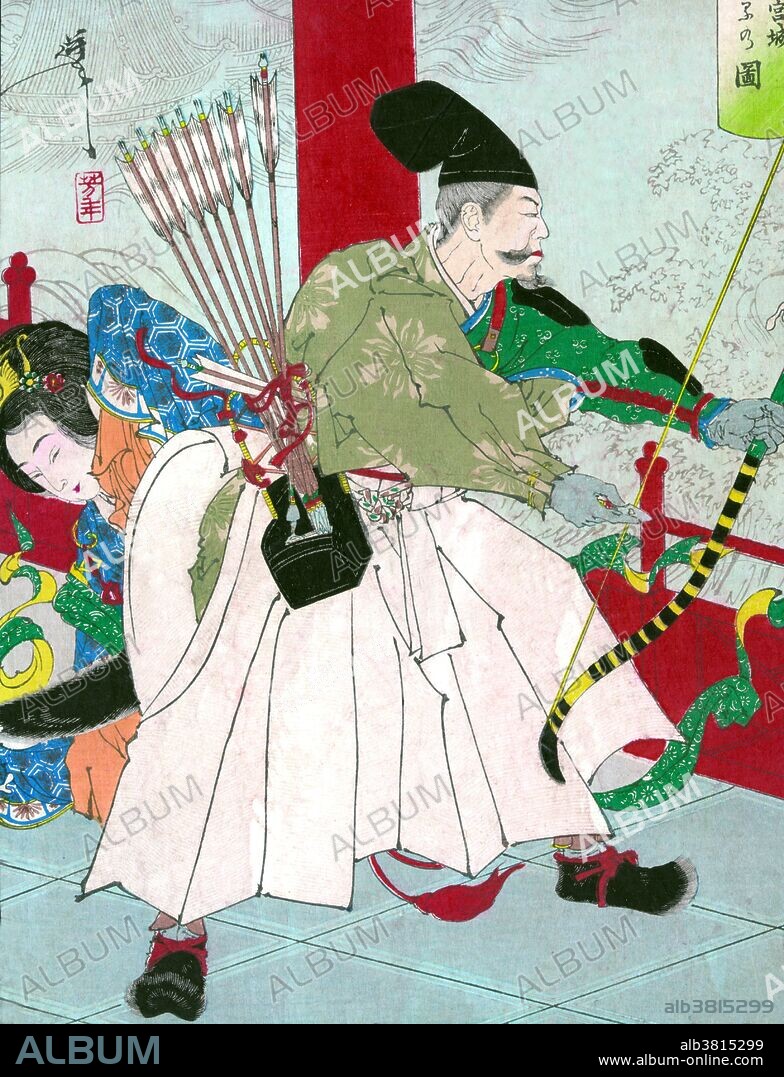alb3815299
Watanabe no Tsuna, Samurai Warrior, 10th Century

|
Ajouter à une autre Lightbox |
|
Ajouter à une autre Lightbox |



Avez-vous déjà un compte? S'identifier
Vous n'avez pas de compte ? S'inscrire
Acheter cette image

Titre:
Watanabe no Tsuna, Samurai Warrior, 10th Century
Légende:
Traduction automatique: Intitulé : « Ryugujo » ; montre le guerrier Watanabe no Tsuna, avec un arc et des flèches, au palais du démon Ibaraki. Watanabe no Tsuna (953-1025) était un samouraï japonais, un serviteur de Minamoto no Yorimitsu, l'un des premiers samouraïs à être célèbre pour ses exploits militaires. Selon la légende de la fin du 10e siècle de la période Heian au Japon, Ibaraki-doji, un Oni notoire, résidait à la porte Rashomon à Kyoto. Ibaraki-doji harcelait les gens qui essayaient de passer par la porte jusqu'à ce qu'un samouraï héroïque nommé Watanabe no Tsuna, un fidèle serviteur de Minamoto no Raiko, vienne maîtriser la créature. Lorsque Tsuna arriva à la porte Rashomon, il fut attaqué par Ibaraki-doji. Cependant, Tsuna était un épéiste fort et vaillant qui était capable de se défendre contre l'attaque féroce. La bataille fit rage jusqu'à ce que Tsuna sorte son katana et coupe le bras du démon. En hurlant de douleur, Ibaraki-doji s'enfuit de Tsuna, laissant derrière lui le bras coupé. Tsuna ramassa le bras d'Ibaraki-doji comme trophée. Lorsqu'il arriva chez lui, il enveloppa le bras coupé et l'enferma dans un coffre. Gravure sur bois de Yoshitoshi Taiso, vers 1880
Entitled: "Ryugujo"; shows the warrior Watanabe no Tsuna, with bow and arrows, at the palace of the demon Ibaraki. Watanabe no Tsuna (953-1025) was a Japanese samurai, a retainer of Minamoto no Yorimitsu, one of the earliest samurai to be famed for his military exploits. According to legend in the late 10th century of Heian Period Japan, Ibaraki-doji, a notorious Oni, resided at Rashomon Gate in Kyoto. Ibaraki-doji harassed people who tried to pass through the gate until a heroic samurai named Watanabe no Tsuna, a loyal retainer of Minamoto no Raiko, went to subdue the creature. When Tsuna arrived at Rashomon Gate he was attacked by Ibaraki-doji. However, Tsuna was a strong and valiant swordsman who was able to defend himself against the ferocious attack. The battle raged on until Tsuna drew his katana and severed the arm of the demon. Screaming in pain Ibaraki-doji ran away from Tsuna, leaving the severed arm behind. Tsuna swept up Ibaraki-doji's arm as a trophy. When he arrived home at his mansion he wrapped up the severed arm and locked it away in a chest. Woodcut by Yoshitoshi Taiso, circa 1880s.
Personnalités:
Crédit:
Album / LOC/Science Source
Autorisations:
Modèle: Non - Propriété: Non
Questions sur les droits?
Questions sur les droits?
Taille de l'image:
3300 x 4310 px | 40.7 MB
Taille d'impression:
27.9 x 36.5 cm | 11.0 x 14.4 in (300 dpi)
Mots clés:
BOIS, GRAVURE SUR • CHEVALERIE • EPOQUE DE HEIAN • ESPRIT • ESPRITS • FANTASME • FANTOME • FANTÔMES • GRAVURE SUR BOIS • GRAVURE TAILLE DOUCE • HOMME • ILLUSTRATION • JAPON • JAPONAIS • JAPONAISE • MYTHIQUE • ORNEMENT, JAPONAIS • PERSONNAGES • PERSONNALITÉS • PERSONNE • REVENANT • SAMOURAI • TAILLE-DOUCE • TECHNIQUE: GRAVURE SUR BOI • WATANABE NO TSUNA • XYLOGRAPHIE
 Pinterest
Pinterest Twitter
Twitter Facebook
Facebook Copier le lien
Copier le lien Email
Email
